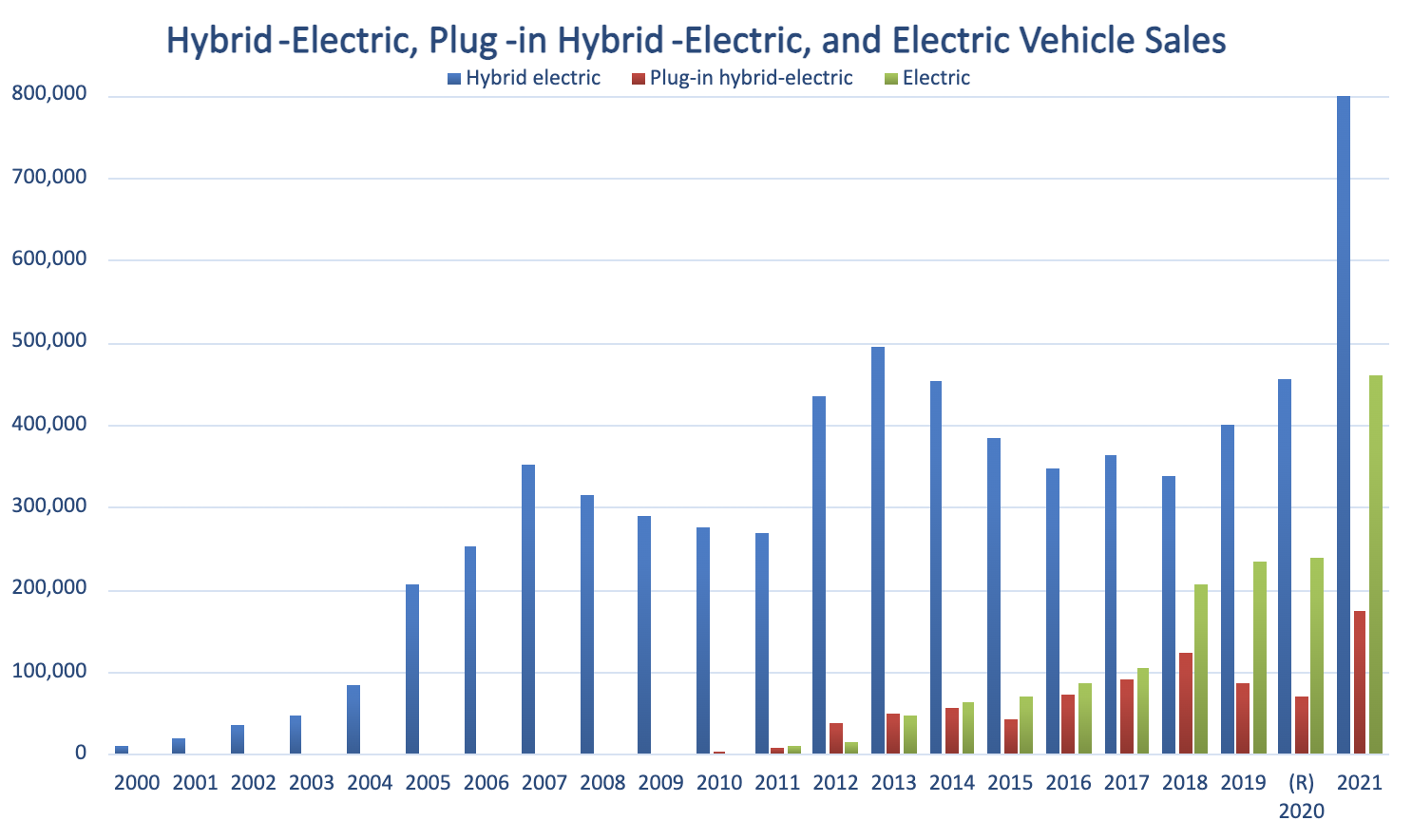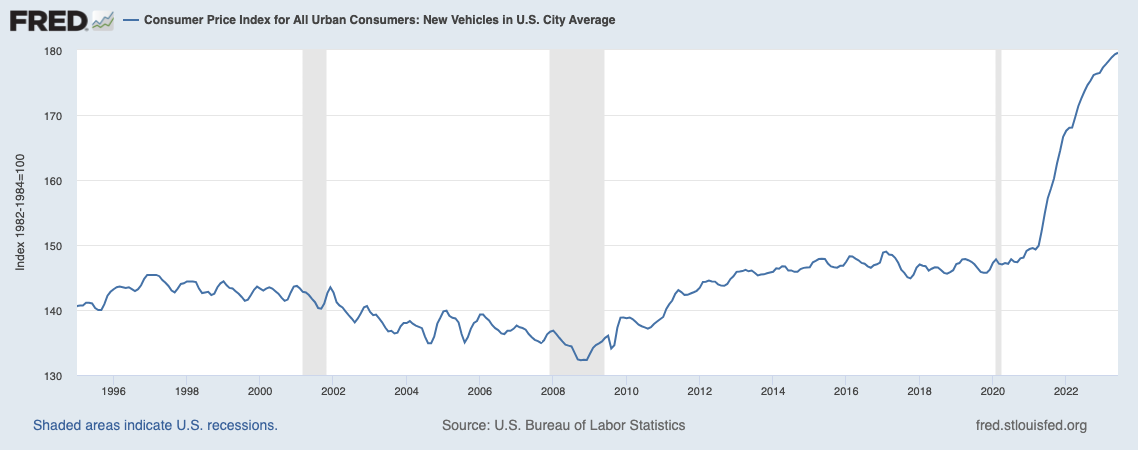Summary
For many years the federal government has incentivized the production and purchase of electric vehicles (EVs) through both subsidies and regulatory nudges. While significant, even combined with state-level subsidies and mandates these forcings have had limited market impact. Despite this evidence of limited demand for EVs, the Biden administration has elected to press forward even more aggressively in attempting to force Americans to switch to EVs. These policy decisions raise the cost of vehicles for all Americans, while also seeking to reduce their choices.
________________
Defining Electric Vehicle
There are three main types of vehicles included in EV counts depending on the source: battery-electric vehicles (BEV), plug-in hybrid electric vehicles (PHEV) and hybrid-electric vehicles (HEV). Both PHEVs and HEVs still use traditional liquid fuels in addition to their batteries. HEVs have achieved significant sales for nearly two decades and continue to outsell BEVs every year by nearly double. When reviewing statistics on EV manufacturing and sales, it is important to check what kinds of vehicles are being counted. BEV and PHEV sales are frequently grouped together in sales statistics, and all three can be combined to present an even more inflated impression of the EV market.
Electric Vehicle Sales
The most recent federal data from 2021 shows almost 460,000 BEVs were sold, representing about 3% of the 15.4 million vehicles sold that year. An additional 173,000 PHEVs and nearly 800,000 HEVs were also sold. These were all significant increases on previous years’ sales. EV sales increased again in 2022, while overall vehicle sales fell to just 14.3 million, leading to numerous headlines celebrating a record percentage of EV sales. Sales estimates vary by source, but using an estimate of 763,000 BEV sales for 2022 would give BEVs a more than 5% market share.
Total vehicle sales in both 2021 and 2022 were well below the typical average for various reasons, with the previous six years ranging between 17 and 18 million vehicles per year. These low sales give an inflated impression of EV market share growth, but by any estimate, EV sales have certainly grown significantly. However, as a percentage of total vehicles in the U.S., EVs are still quite small. Taking the Biden administration’s estimate of 3 million EVs on the road today, EVs represent about 1% of the 290 million vehicles in the U.S. EV prices remain consistently higher than prices for internal combustion (ICE) vehicles. While EV sales have increased, they are still a niche product in the motor vehicles market.
Federal Support for Electric Vehicles
Prior to the Biden administration, subsidies and regulatory nudges in favor of EVs did exist. An EV tax credit of up to $7,500 was available for the purchase of a qualifying plug-in electric vehicle. However, this was subject to a cap of 200,000 vehicles per manufacturer. A previous tax credit had also existed for HEVs during the 2000s. All three types of EVs were given significant weight in the calculation of Corporate Average Fuel Economy (CAFE) standards and could be used to comply with EPA tailpipe emissions regulations. Carmakers thus had an incentive to produce more EVs to help their fleet average compliance, regardless of demand from consumers. The Obama administration attempted to use CAFE standards in particular to force the pace of EV adoption, setting standards so stringent that the only means of compliance for carmakers would be to manufacture a substantial number of BEVs, though the Trump administration later reformed those standards to more reasonable levels.
These tax and regulatory incentives had a limited effect on sales of BEVs, though perhaps contributed to the growth of HEVs as a market staple. See Figure 1.
Figure 1

The Obama-era regulations did have an impact on new car prices. While new car prices had been gradually falling in the 1990s and 2000s as a result of manufacturing improvements, like other durable goods such as TVs and appliances, in the first half of the 2010s new car prices turned sharply higher. See Figure 2.
Figure 2

Biden Admin Puts Support In Overdrive
The Biden administration has taken previous federal support for EVs and kicked it into overdrive, while at the same time directing every arm of the federal government to work to increase the cost and restrict the availability of ICE vehicles.
- In the Inflation Reduction Act (IRA), the numerical cap for the EV tax credit was eliminated, making the federal subsidy indefinite. The IRA also included subsidies for the manufacture of EV battery modules.
- The Infrastructure Investment and Jobs Act (IIJA) included $7.5 billion in subsidies for EV charging stations.
- The EPA has proposed a tailpipe emissions rule that sets emissions standards so strict that the only way for car manufacturers to comply is to produce EVs. This de facto EV mandate may very well be overturned in the courts, but it will do significant damage in the interim as carmakers attempt to comply.
- EPA and the National Highway Traffic Safety Administration (NHTSA) proposed new CAFE standards for 2024-2026 which are a 43% increase on the standards set by the Trump administration. The administration is also expected to propose CAFE standards for 2027 and beyond that mirror the EV mandates in the EPA tailpipe emission rule.
- The Department of Energy has proposed reducing the mileage ratings for EVs used for compliance with CAFE standards. Reducing this mileage credit will force carmakers to produce even more EVs in order to comply.
- The EPA proposed including EVs in the Renewable Fuel Standard (RFS) program, making EV manufacturers qualify as producers of compliance credits which would have provided another line of subsidy for the manufacture of EVs. The final RFS rule did end up backing away from this blatantly illegal move.
- The administration has granted California waivers from federal law to impose bans on ICE vehicles.
- The administration has pressured all executive branch departments and agencies, including even the armed forces, to develop and use EVs for their vehicles.
Higher Costs and Less Choice
The Biden administration’s efforts to force EVs onto the market have wide-ranging effects. CAFE standards raise the cost of new vehicles. Automakers (with the possible exception of Tesla) lose money on every EV they sell: GM does not expect to turn a profit on EVs before 2025, Ford expects to lose $3 billion this year on EV sales, and Stellantis is also struggling with EV costs. Carmakers cannot absorb such losses, and therefore have to raise prices for vehicles with strong consumer demand, like pickup trucks. State-level zero emission vehicle mandates permitted by the federal government similarly increase overall vehicle costs because companies must pass on the cost of required sales of loss-making EVs.
There is also a question of how much consumer demand there is for EVs at their higher prices. EV prices have not reached parity with ICE vehicles, and battery prices (the largest cost component of EVs) have even increased in recent years. Consumers will always tend to choose the less expensive option between two otherwise comparable vehicles. Consumers also continue to have reservations about battery ranges, the length of charging times, and the limited resale value of older EVs.
These limitations on EV demand are why the Biden administration feels the need to heavy-handily force EV adoption. After all, if EVs were affordable, popular and more desirable than ICE vehicles they would be expected to win out in the marketplace. The only way for EVs to dominate the market the way the administration would prefer is to increase the cost of ICE vehicles and to limit consumers’ ability to purchase ICE vehicles. But polling consistently shows that voters oppose EV mandates and don’t want bureaucrats telling them what kind of cars they can buy.
Conclusion
Under the Biden administration, federal EV policy has been warped from simply subsidizing an emerging alternative product category into a whole-of-government attempt to control the lives and choices of the American people. In order to overcome the inherent limitations on organic demand for EVs, the administration has decided it will try to force consumers into EVs. Since the administration does not have the power to ban ICE vehicles outright, it is resorting to a backdoor mandate by forcing carmakers to transition to manufacturing EVs, regardless of market demand. This is an abuse of existing authorities, some dating back to the 1970s, which were never intended to be used for climate change-focused social engineering.



